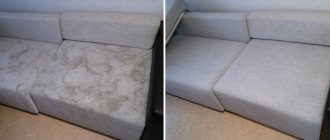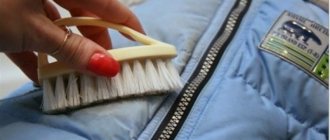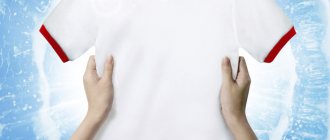Prices for dry cleaning services are rising and will soon be commensurate with the cost of a new item. Of course, it's a shame to waste money. You have to take on the task of removing contaminants yourself. It could be an unpleasant surprise. After washing there are some white streaks left, what should I do in this situation? Don't get upset and don't scold yourself. We'll fix everything. You need to understand the causes of stains and streaks and find a way to get rid of them.
Reasons for the appearance of stains and streaks after washing
The color of the stains that appear on the surface of the fabric after drying the product partly helps determine the cause of the problem. White stains are, as a rule, unwashed remnants of laundry detergent. It's easy to get rid of such marks. If a composition with bleaching components was used, then whitish spots and stripes may indicate damage to the fabric of the down jacket.
The appearance of dark or yellow stains is caused by other reasons. It could be:
- “shedding” of down jacket parts made of darker fabric;
- dirt that hasn't been washed off;
- a wet down jacket lying in the drum of a washing machine for a long time;
- improper drying of the item;
- fat and dirt from natural filler (if poorly cleaned down was used in the manufacture of the jacket).
Depending on the reason for the appearance of stains on the down jacket, you should choose a way to deal with them.
Problem areas
Most often, the sleeves and collar of any item require cleaning. They are usually the first to become contaminated. How to clean the sleeves of a down jacket and its collar? To do this, you will need a solution of any powder or detergent. With a brush dipped in it, these most problematic areas are wiped. In this case, the rest of the down jacket should be dry. Remains of the cleaning solution are removed with a sponge or cloth.
How to clean the collar of a down jacket if it is trimmed with fur? If natural skins are used when sewing a product, washing this part is strictly prohibited. The fur parts are cleaned by combing with a brush.
How to prevent stains and stains from appearing
If the down jacket is of good quality, and the product labels allow “water procedures,” the appearance of streaks after washing can be completely avoided. To do this you need to follow a number of simple rules:
- follow the manufacturer's instructions on the labels;
- properly prepare the item for cleaning;
- use a special liquid product in moderate dosage;
- wash a down jacket separately from other things;
- choose a gentle mode, water temperature – no higher than 30-40 degrees;
- the down jacket needs to be rinsed very thoroughly (+3-4 rinses to normal);
- spin in a washing machine (machine washable);
- Dry correctly and quickly, do not allow the wet down jacket to “sit” in a basin or machine.
As a rule, this is enough for a jacket with natural filling to look like new after washing.
If foam bubbles remain on the surface of the washed down jacket, the product was not rinsed well, and after drying, stains may appear on it. It is better to immediately start an additional rinse cycle or pour warm water over the surface from the shower.
How to restore the appearance of a leather jacket?
Many housewives only think about how to clean the sofa or clothes from dust, paint or animal hair. But it is much more important to cleanse the body of parasites so as not to get sick, because parasites are not only banal worms, they are many different forms that have long been proven to be the cause of many ailments, from allergies and asthma, to skin problems, dermatitis, and frequent colds , acute respiratory infections, headache and hypertension.
In addition to all this, parasites are the cause of many cancers. We read how to properly cleanse the body in an exclusive interview with chief parasitologist Dr. Rykov.
Read more.. » Cleaning greasy stains Oily stains from the skin can be effectively removed with gasoline. To care for leather clothing, you can only use pure gasoline, preferably aviation grade.
If it is not possible to find such gasoline, it can be replaced with turpentine.
Drying rules
A common reason for the appearance of streaks on a down jacket is errors during drying. Drying winter clothes properly is almost more important than washing them properly. It's all about the “capricious” filler, which does not tolerate water well. Pooh can:
- clump together in dense lumps;
- start humming and “emitting” an unpleasant odor;
- lead to the appearance of stains on the down jacket.
The choice of drying method depends on several conditions - the type of filler, the size of the “cells”, the fabric of the “top”, the washing method, the recommendations on the product label. As a rule, the manufacturer indicates the preferred drying method - horizontal or suspended. The following recommendations are general for any winter clothing:
- You need to start drying your down jacket immediately after washing. Do not leave a wet product lying in the basin or drum of the machine.
- Spinning in the washing machine (at minimum speed) will significantly speed up the drying process. You cannot wring out items with down filling by twisting them.
- Good ventilation. The drying room should be well ventilated (the bathroom is not suitable, it is too damp there, so the drying process will be delayed).
- It is correct to dry a down jacket in a straightened, unbuttoned position. Air must come from all sides. To do this, you can hang the product on hangers. If the manufacturer recommends drying a down jacket horizontally, it should be laid out on the dryer rack to ensure even drying.
- Do not dry your down jacket on a radiator, heater, or in direct sunlight. The occurrence of divorces is almost inevitable.
- During the drying process, the down jacket should be shaken and turned over frequently (for example, every hour). This is necessary to prevent the fluff from compacting and starting to fray. Alternatively, you can beat the fluff with blows from a carpet flapper or a stick.
In total, the drying process should take no more than two days, otherwise an unpleasant odor will appear. Only completely dried items can be put into the closet.
How to remove yellow stains from white clothes?
All methods for removing yellow spots on a white jacket, shirt, T-shirt and other wardrobe items can be divided into 3 groups:
- homemade recipes;
- special stain removers;
- washing powders.
When using techniques, it is important to know which of the remedies will help in a particular case - you need to take into account the intensity of the stain, the cause of its appearance, and localization
Removing yellow stains from white fabric using folk remedies
Folk remedies for removing pollution:
- Laundry soap + oxalic acid. Apply a thick solution of soap to the fabric and rub with a brush until foam forms. After half an hour, treat the area with a weak acid solution. After 10 minutes, rinse the item thoroughly.
- Soda. Baking soda is mixed with water. The pulp is rubbed into the fabric with a brush into the armpit area. Place the item in a plastic bag to prevent the composition from drying out and leave for several hours.
- Peroxide. Get rid of yellow sweat stains on white with hydrogen peroxide in 2 ways. The first one is to take 1 tbsp for 1 liter of water. l. hydropyrite. Immerse the item in the solution for 30 minutes, then wash. Second - apply a mixture of 2 tbsp to the stain. l. soda and 1 tsp. means intended for washing dishes. The treated area is generously watered with peroxide and left for 2 hours.
- Aspirin. Knead several tablets of acetylsalicylic acid and mix with water until a paste is obtained. Rub the mixture onto the stain. They wash the item after a couple of hours.
- Vinegar. This product can help remove yellow deodorant stains on white fabric. Rub 9% vinegar into the problem area with a cotton pad. You can also soak clothes for half an hour in a solution of 5 liters of water and 2 tbsp. l. vinegar. Then treat the stain with soda slurry.
- Ammonia. Mix 1 tsp. denatured alcohol and ammonia. Pour the solution over a yellow stain on a shirt or other item. When the yellowness disappears, rinse thoroughly.
- Vodka. Prepare a 50% solution of alcoholic drink, moisten a cotton pad and wipe the contaminated area. It is better to use well-purified vodka, otherwise stains may appear on your clothes.
- Digestion. The old method of how to bleach yellow spots on white is used for items made of cotton - other fabrics become deformed and shrink after boiling. Pour water into the container, add shavings of laundry soap and chlorine-free bleach. Place clothes and simmer over low heat for 1-2 hours. To remove the strong smell of soap, you can add fabric softener to the container.
In most cases, folk methods are good against fresh stains.
Removing stains using stain removers
There are many products available for removing yellow stains on white T-shirts, shirts, etc. Such preparations are often used if home methods do not help - stain removers contain highly active components that, if used frequently, harm the fabric. The line includes powders, gels and solutions. The instructions describe in detail what fabrics the stain remover is suitable for and what stains it effectively removes.
General algorithm for removing yellow spots from a white jacket, dress, T-shirt, etc.:
- moisten the problem area with water;
- apply stain remover;
- maintain the time specified in the instructions.
You can increase the effect and reduce water hardness by mixing the product with a weak solution of soda ash or citric acid.
How to remove old yellow stains on white?
If yellow stains appear on a white shirt, you can use washing powders with a bleaching effect. General algorithm:
- For light soiling, wash normally. When the stains are old, the item is pre-soaked or a stain remover is applied to problem areas half an hour before loading.
- Select the washing program and spin speed, taking into account the type of fabric. If there is no information on the label, it is better to use the delicate mode for synthetics.
- If you don't have a special powder for whites, you can add oxygen-containing bleach to the water. Good results are achieved by adding dishwashing detergent to the water - they do an excellent job of removing grease and ridding clothes of traces of sweat.
- It is advisable to dry your wardrobe items in the sun, in the fresh air. Direct sunlight has whitening properties. However, such drying is undesirable for items made of terry and delicate fabrics.
When yellowness appears during washing, there is no need to use special chemicals or folk remedies. You need to rinse the item thoroughly in cold water.
Other recommendations
To get rid of stains on a down jacket at home, you should know a number of other nuances:
- Before using the stain remover, you should try it on an inconspicuous area of the fabric on the inside of the product.
- It is better to remove stains on a down jacket immediately after washing. Getting rid of old, stubborn stains will be much more difficult.
- If the down jacket is made of fabrics of different colors, then the colors may “bleed” when washed independently. It will be impossible to fix this, so it is better to clean such a thing “locally”, without soaking the whole thing.
- If you put several tennis balls into the drum of the machine along with the jacket, the fluff will “crumple” less and the likelihood of streaks will decrease.
To avoid problems when washing a down jacket, you should choose high-quality items from reliable brands, and also follow all the instructions on the product label. You can hopelessly ruin an item if you wash it with aggressive detergents (with bleach) or in too “severe” mode. In other cases, the negative consequences of “water procedures” can be corrected using the methods described above.
We bleach yellowed rubber and uppers on sneakers and sneakers.
Using simple improvised means that everyone has at home, it’s easy to literally make rag sneakers or sports sneakers “brand new” again in just 5-10 minutes. If the first remedy from the list below helped you, great, but if not, keep trying, something will definitely work and your shoes will become white again)
Washing powder or laundry soap. Pour warm water into a basin and generously pour in washing powder or cut half a bar of soap. Let the powder and soap dissolve. Place your shoes so that only the soles are in the water. Leave the rubber to soak for 30-50 minutes. When you return, scrub away the yellowness with a stiff brush. You can use an old toothbrush - it will be more convenient. Patience and work, friends)
A regular office eraser can remove black streaks. Rub it vigorously over dirty strokes. You may have to try several erasers before you find the right one that will remove streaks most effectively.
It's easy to bleach gray sneakers with baking soda. Mix it with table vinegar (9%) in a 1:1 ratio, knead the “porridge”. Use plastic or glass containers to avoid unexpected reactions. You can only use a paste of baking soda and water. Place the shoes, cleaned of most dirt, in a basin. Dip the brush into the prepared mixture and scrub the shoe. You can leave the mixture on dirty places for 20-30 minutes, and then completely remove all the yellowness with soda.
Bleaches.
- Choose ones that do not contain chlorine. It has a bad effect on both the rubber of sneakers and the textile upper of the sneaker.
- Apply a gentle product to the stained areas for half an hour, then scrub off with a brush what remains of the yellow spots and black stripes.
- Add it when washing in the washing machine or by hand along with detergent.
- Or soak the soles in a strong bleach solution for half an hour, as with the powder.
I sometimes see conflicting advice on the Internet about using bleach on cloth shoes. Some complained that it was also capable of leaving yellow streaks. Nonsense or does it still happen? This has never happened to me, but to you? Write in the comments, let's discuss)
Let's clean the yellowness and grayness with crushed white chalk, toothpaste or powder (it's better to take whitening). They must be white; dyes in colored pastes or chalk can transfer to shoes. When using tooth powder and chalk, first dilute it with a few drops of warm water until a creamy mass is formed so that its granules do not scratch your boots. Apply a pea-sized amount of paste to a sponge or brush and wash your sneakers. For deep stains, leave the paste on them for a couple of hours, then finish what you started.
Citric acid, lemon, lime. Lightly dilute lemon juice into a paste with water and rub with a sponge or rub with a fresh slice of lemon until the sneakers are whitened.
Refined gasoline or kerosene. Stubborn stains are removed with a cotton swab soaked in them. Afterwards you need to wash it to get rid of the smell.
Nail file or sandpaper. This is a more radical mechanical method that will literally scrape off the surface yellowness from the soles of sneakers. Use the finest grain so as not to scratch the floor of the shoe. Experiment with grain, try something tougher in advanced cases
Begin planing carefully and carefully. At the end, it is advisable to “seal” the treated areas with polishing
Acetone, ammonia or hydrogen peroxide can wash the rubber on sneakers and sneakers. They are known to have bleaching solvent properties. Take pure acetone or a product containing it, such as nail polish remover. Dip the cosmetic pad and rub the desired areas until the sole or top turns white. Another recipe. In 5 liters of water at room temperature, dilute 1 tablespoon of ammonia and peroxide. Soak the boots for half an hour, wipe with a brush, wash in a machine or by hand.
The very last resort, when nothing helps, is special paints for shoes (sold in shoe stores) or acrylic paints for fabric or rubber (can be bought in art stores). If you've tried everything and nothing helps, make up your mind: buy it and paint over everything). This method will certainly get rid of yellowness on your shoes 100%.
And if you don’t want to do this, and are generally tired of fiddling with white shoes, go to the dark side - buy black shoes, and do this with dying light shoes:
and everyone will be fine)
How to clean greasy areas
The fastest places to get greasy are the areas near the pockets, cuffs and collar of a down jacket. To get them in order, try pouring salt, starch or talc onto the shiny areas, wait until the powder “pulls” the fat out of the material and remove the substance from the clothes. But if the grease is severe, this method may not help. In this case, prepare the following composition:
- Ammonia – 1 tsp;
- Liquid stain remover or dishwashing detergent - 1 tsp;
- Half a glass of water.
The author of the video will tell you how to get rid of greasy areas on a down jacket:
Beat the foam with a sponge and apply it to the shiny areas. Wait 15 minutes, then rinse off with clean water.
Another option is to use a glass cleaner in a spray bottle. Spray it on the contaminated area and rub with a cloth. If the stains do not disappear the first time, repeat the procedure. Finally, rinse the fabric with clean water.
The described methods will help you easily remove stains of various origins from your down jacket. If some remedy does not help, do not despair, turn to other methods to achieve the desired result.
Household chemicals
The easiest way to remove shiny marks from fabric is to treat the item with household chemicals. Now there are even special sprays on sale specifically against shine on jackets.
For such purposes, “Vanish” is ideally suited; it is used to treat shiny marks on the product, leave it for literally 10 minutes, and then wash it off.
Most often, the collars of jackets and pockets become greasy. You can use simple laundry soap 72%. To do this, you need to moisten the cloth with warm water and then soap it generously with a bar. In an hour the item can be washed. Regular washing powder also works great to remove shine, but you need to select it according to the type of fabric.
If greasy stains are deeply embedded in the material, an excellent remedy for dirt is a dishwasher. The gel is applied in concentrated form to the fabric, left for 15-20 minutes, and then the item is washed.
Available means
But if you don’t like to use aggressive chemicals, or the material of the jacket is delicate, then you can try to remove dirt using improvised means that have been tested by every housewife. A Bolognese jacket can also be cleaned using traditional methods.
Ammonia
A great way to wash greasy areas on a jacket is with ammonia. Ammonia can be used to clean both bologna fabric and suede. Mix 50 g of ammonia and 200 ml of warm water. Then moisten a sponge in the solution and begin to treat the areas that are shiny with it. After this, the product is rinsed in cool water or a weak solution of vinegar and left to dry. This method helps not only to scrub off areas that become greasy, but also to refresh the material as a whole.
Dish gel + soda
A good way to wash a greasy collar or cuffs is to treat them with a mixture of dish gel and baking soda. Mix soda with detergent to form a paste. Then rub this paste on the damaged areas of the fabric and leave for 10-15 minutes. After this, the clothes can be rinsed in cool water and put into the washing machine.
Potato
How to clean a leather jacket? Simple potatoes will do the trick. The leather becomes as greasy as the bologna fabric. Use a cut of raw potato to treat all the shiny areas and leave the juice until it dries. Then the dirt is removed with a regular clothes brush.
Petrol
You can also clean your skin with household gasoline if the smell doesn’t bother you. Such gasoline can be bought at households. stores Soak a cotton swab in the substance, and then use it to clean all the areas that are most often greasy. In extreme cases, gasoline is suitable for refilling lighters.
Alcohol + salt
This method using alcohol and salt is suitable for all types of materials. First, the shiny areas are generously wiped with medical alcohol or even vodka. Then salt is poured thickly onto the still wet footprint. The salt must be fine. After a few minutes, the clothes can be brushed and machine washed.
Glycerol
This pharmaceutical product has always helped to cope with even the most stubborn stains on a wide variety of materials. It will help in this case too. All shiny places on the jacket are wiped with pure glycerin using a cotton swab. The product is left for 15 minutes, and then the material is washed in powder or with household items. soap. After such manipulations, the jacket can be loaded into the washing machine. Don't be discouraged if your new jacket quickly develops shiny areas - they can be easily washed off. Take the advice of experienced housewives, choose the product that you have on hand, and start fighting stains.
Rules for cleaning a down jacket
There are many ways to get rid of stains; experienced housewives suggest using various available means for this. But first you need to have general rules for cleaning a down jacket from dirt, which will help preserve the product without spoiling it with improper manipulations:
before using a special aggressive stain remover, it is necessary to remove other existing contaminants (it is important not to damage the fabric); a blot of any origin is cleaned off, moving towards the center of the contamination (so as not to smear the dirt even more); after cleansing, be sure to remove any remaining product using regular running water; the area outside the blot is thoroughly moistened with plain water (if the jacket cannot be washed further, this will help avoid streaks).
Only after drying, the jacket will “show” the result of the housewife’s labors. If there are still residues of a greasy substance or stains at the spot, all manipulations must be carried out again or the jacket must be dry cleaned.
Some final tips
- Do not wash your down jacket often; mechanical stress limits the wear time. Alternate between washing and dry cleaning.
- It is better to dry clean white down jackets and expensive jackets with various protective coatings - washing destroys the top layer.
- If you were unable to cope with fabric stains using one of the selected methods, you should not experiment further. Fabric deteriorates due to numerous chemical influences. Use either a high-quality stain remover or dry cleaning services.
Do not wear things out, choose a well-ventilated place to store them at home, store white clothes in covers in summer and shake them out periodically. Little household tricks will help you look impeccable.
How do you like the article?
It's time to change the filter
Gray stains, matted flakes of dirt, stains - all this may indicate that the filtration system is clogged. Freshly washed items give off a musty smell that cannot be eliminated by repeated washing. Over time, this smell begins to spread throughout the room where the device is located.
Dirt constantly accumulates in the filter, and fungus and mold can grow on it. If measures are not taken in time, the filtration system will fail and will have to be replaced. How to prevent filter damage:
- after washing fur and fleecy items, the filter must be removed and washed;
- The drum door must be kept open;
- periodically (once every 3–6 months) run a wash cycle with clean water and citric acid at a temperature of 90 degrees.
Peroxide
The principle is the same as using ammonia. They replace each other well.
How to use:
Dissolve 1 tbsp. l. peroxide in 75 ml of water, apply on top and do not touch for a couple of minutes. Rinse your clothes well in clean water.
Note:
This method is also only suitable for thick white fabrics.
Photo: severdv. ru











